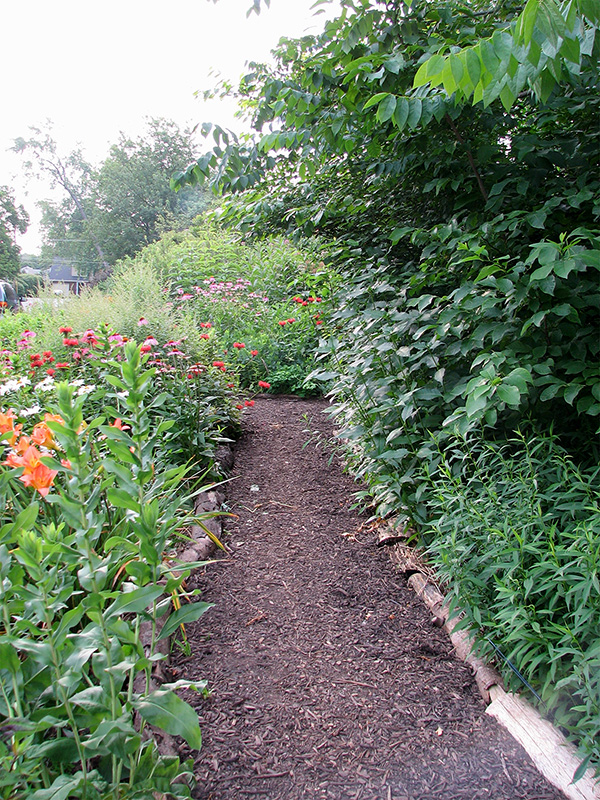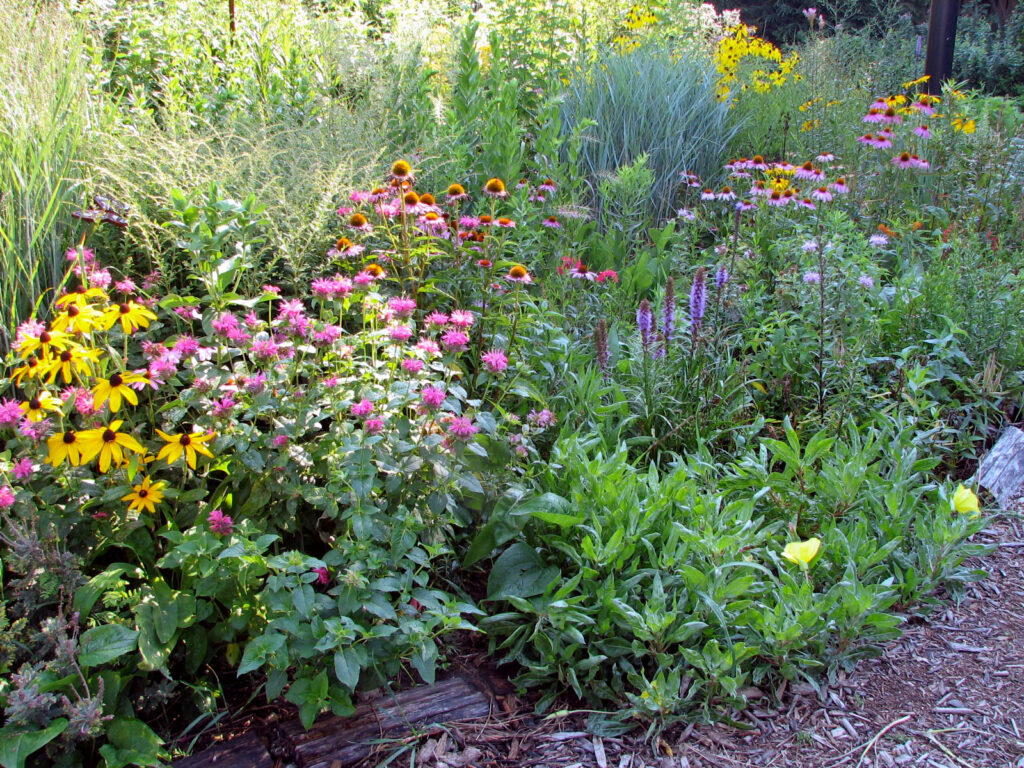Like others concerned about climate change, we’re striving to reduce our carbon footprint by using LED lights, driving a plug-in hybrid, and reducing our fossil fuel use in other ways. Just as important, we’re also creating a climate-friendly landscape.
This is an excerpt from the Wild Ones Journal
Current members can log in to read the latest issue or check out the Journal Archives.
Editor’s Note: A 2019 United Nations 1,500-page report, compiled by hundreds of international experts, warned that humans are transforming Earth so dramatically that 1 million plant and animal species are now at risk of extinction. However, the report also stated that many of the worst effects can be prevented by changing the way we grow food, produce energy, deal with climate change, and dispose of waste. It will take a concerted effort by governments, companies, and people like you.
We plant LOTS of plants
Native, of course, since they’re the ones that support life on Earth! After all, what good is a planet with a stable climate if it doesn’t support life?
But which native plants? In this unprecedented planetary experiment, previous patterns of temperature, precipitation, and storms will not predict future ones. Hardiness zones have already been revised. Zone 4 of my childhood is now Zone 5, and further changes are expected in the next 30 years. Will plants in their current native range survive there in the future? Will the advantages of local ecotype persist when winter lows plummet and summer highs spike? No one knows, but we’re trying to future-proof our landscape by choosing new plants from the center or northern part of their current native range.
We grow a diversity of wildflowers, grasses, shrubs, understory trees, and a few canopy trees to increase the chance that some will adapt to changing conditions. And for the same reason, we choose straight species rather than cultivars to increase genetic diversity.
We reduced our lawn
How did we find space in our modest-size suburban yard for so many plants? By eliminating most of the lawn! Lawn may be climate friendlier than asphalt, but any carbon it sequesters or oxygen it produces pales in comparison to other plants. Picture a landscape of perennials, shrubs, and trees and consider how much more carbon they put into the soil and how much more oxygen those plants will produce in the same amount of space. And large trees not only put carbon into the ground but also store it aboveground.

Another problem with lawns is the polluting (and noisy) power equipment used to maintain them. We got rid of our old gas mower and bought a small, quiet electric one. We mow our mini-lawn in just 7 minutes, creating much less pollution.
In fall, rather than use a noisy, polluting leaf blower, we rake leaves (free exercise!) on our tiny lawn and add them to the compost bin or pile them on our vegetable beds for the winter.
Perhaps less obvious sources of climate pollution are the chemical fertilizers, pesticides, and herbicides used on lawns. Not only do they directly cause problems—such as fertilizers breaking down into the potent greenhouse gas nitrous oxide—but producing, packaging, and transporting them is also carbon-intensive.
We maintain our small lawn without any chemicals by mowing it slightly higher, leaving the clippings on the lawn, and hand-digging intrusive weeds. We never water it. Though it might not star in a lawn product commercial, it compares quite favorably to the chemically treated, routinely watered lawns in the neighborhood.
We nurture the soil
When we first started gardening many decades ago, we believed that using a rototiller and double-digging our garden was the best thing we could do. Now we know better! Each time we disturb the soil, it releases some of the stored carbon, allows weed seeds to germinate, damages the soil structure, and is bad for soil microbes and fungi. We try not to walk on the soil to protect the soil structure, and we limit digging.
We don’t have much bare soil in our habitat garden. Our perennial beds are self-mulching since we let plants fill in close to each other, keeping the ground moist and crowding out potential weeds. We also plant herbaceous plants under trees and shrubs. We leave most of plants’ own stems and leaves where they fall, so they can feed soil microbes and provide a home for beneficial insects.

We grow food
We’re especially interested in providing habitat for wildlife, but we also believe it’s important to use some of our yard to grow our food. The organic fruits and vegetables we produce require no fossil-fueled transportation and are the healthiest, tastiest food we could eat. We have permanent beds and plant cover crops so the soil isn’t bare over the winter.
We recycle garden waste
Organic waste decomposing in landfills generates methane, a potent greenhouse gas, so we try to keep our plant and food waste in our yard. We compost yard waste in compost bins and sometimes just in piles in out-of-the-way places. We compost food scraps in indoor worm bins and use the vermicompost in our edible garden.
We plant to save energy
A windstorm with strong, straight-line winds that blasted through our area in 1998 provided a vivid demonstration of the cooling effect of trees. That powerful storm knocked down the large maples that had shaded our south-facing porch. What had previously been a pleasant place to sit in the summer became an oven. We soon planted a red maple on the south side of the house and just a few years later it began to shade the porch, making it comfortable on all but the hottest days.
The trees and shrubs on the south side of the house allow us to use air conditioning very sparingly and those on the north, by buffering winter winds, help moderate our need for winter heating.
In fact, our yard is much more comfortable than a conventional landscape would be. On hot summer days, the parts shaded by trees and shrubs are objectively much cooler than nearby parts in the sun. But besides the actual temperature difference, the shady areas feel cooler because of the transpiration of the trees’ leaves, and because humans perceive a shady, forest-like area as cooler.
We save energy in the garden
We use motion-detector security lights outside so they use electricity only when some movement activates them, not all night. And we definitely don’t use electric lights aesthetically to highlight trees, walls, or anything else. This isn’t a responsible use of fossil fuel! (And that unnatural night light harms nocturnal creatures, too.)
I never have enough space to grow everything I’d like, but I still make room for my “solar” clothes dryer so we don’t need an electric dryer, a very high energy use appliance. A bonus: It’s a good excuse to be outside in the cool morning air, serenaded by birds. And it really doesn’t take very long once you get the “hang” of it.
We participate in community science
The changing climate is affecting plants and, thus, life on Earth, and we need to learn more to make informed decisions about this new reality. Scientists can’t do it alone, so we’re participating in BudBurst, a plant phenology project that tracks the timing of plants’ life cycle events. The more people who collect this information, the more we’ll know about how plants are reacting to the changing climate.
We can all make a difference
It’s easy to feel helpless in the face of a major global challenge like climate change. Although individual actions aren’t sufficient, they’re necessary and can make a difference if enough people act. And knowing the risks of climate change and ecosystem collapse to our grandchildren’s future, how could we not take every action we can? You can be part of the solution, too, by creating your own climate-friendly landscape.
To learn more
I highly recommend the book, “Climate-Wise Landscaping: Practical Actions for a Sustainable Future” by Sue Reed and Ginny Stibolt. It has lots of how-to’s and why-to’s for every aspect of creating a truly sustainable landscape.

